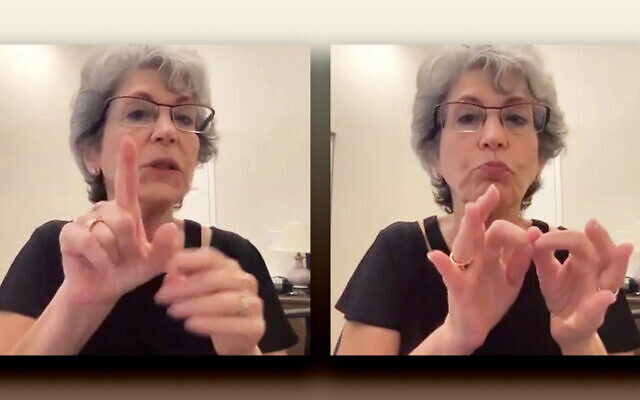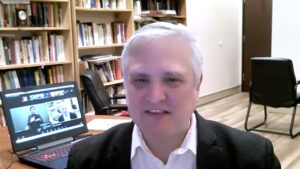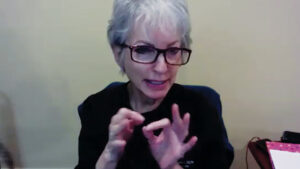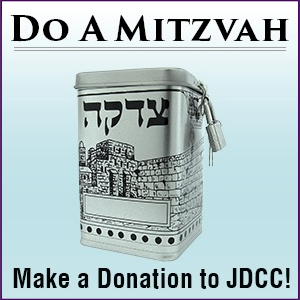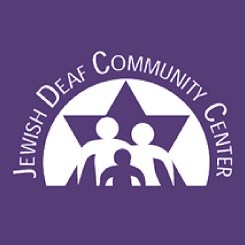Media: Susan Cohen, the president of the Jewish Deaf Resource Center, signs during a Zoom session of Etzba Elohim.
Academy for Jewish Religion, Jewish Deaf Resource Center offer ASL certification program
By JOANNE PALMER
February 23, 2022, 6:58 pm
JewishStandard
Together, the Academy for Jewish Religion and the Jewish Deaf Resource Center are offering a program that will certify American Sign Language interpreters and Deaf community prayer leaders by training them in the depth and meaning of the liturgy they already have the tools to interpret on a less profound level.
The Academy is an accredited program that ordains rabbis and cantors and gives graduate degrees; it’s pluralistic, nondenominational, aimed to a large extent at second-career students, based in a beautiful, light-filled old brick building on the Yonkers waterfront, and led by its CEO and academic dean Ora Horn Prouser of Franklin Lakes. The Westchester-based Jewish Deaf Resource Center connects Deaf Jews with Jewish institutions and advocates for them.
The program is called Etzba Elohim, the Fingers of God.
That’s because “those who speak with their hands, the Deaf community and ASL interpreters, are speaking in God’s image,” Dr. Prouser said. “God uses divine fingers in the Bible to achieve miraculous results, and, to write the Ten Commandments. So when we use our hands to communicate, whether as the Deaf community, or as ASL interpreters, we are acting in the divine image.”
Over the course of three semesters, students will focus on the liturgies specific to Friday night, Shabbat morning, Rosh Hashanah, and Yom Kipppur, as well as life cycle events. They’re taught by AJR faculty — the first session’s faculty member is Rabbi Robert Scheinberg, who like many AJR teachers has a day job leading a shul, in his case the the Conservative United Synagogue of Hoboken. There also are two ASL interpreters at each class.
The formal class meets once a week, on Tuesdays; there’s also a weekly session, called the Liturgical Lab, on Thursdays, where students can talk about what they’ve just been taught.
The courses are online; that’s a pandemic necessity but also an active good, because it allows students and Deaf community leaders from around the country to join. Dr. Prouser has known about the need for a program like this for decades. She had been teaching at the Jewish Theological Seminary, where she also earned her doctorate, when she had a Deaf student in a master’s program. “She used to come to class with a note-taker and two interpreters,” Dr. Prouser said. One of those interpreters was Naomi Brunnlehrman, the activist who now is the executive director of the Jewish Deaf Resource Center. “I learned a tremendous amount,” Dr. Prouser said.
Among the many things she learned, “because Naomi kept telling me, was that ASL interpreters in the Jewish community often don’t have a strong Jewish background, so when they interpret, they don’t go into depth. What they were giving the Deaf community was a water-down view of Judaism. Naomi had masters’ degrees in Jewish studies, both as an educator and as an interpreter, so it was painful for her to see that people weren’t getting what they should have gotten.”
About 15 years ago, Dr. Prouser started to apply for grants for a program like the one the AJR now has begun. It frustratingly didn’t work. “And then Naomi and Susan” — that’s Susan Cohen, a librarian and longtime Deaf activist who’s now the ADJC’s president — “said, ‘We have a small grant. Are you ready?’
Media: Dr. Ora Horn Prouser
“And I just jumped.”
Ms. Cohen and Ms. Brunnlehrman used email to explain what the new course offers, and why it matters.
They started with the issue of translation, which is not a simple matter of using one sign for every one word, in order, in some sort of mechanical fashion.
“As a three-D visual language, ASL does not follow English word order, and it has its own syntax,” Ms. Cohen said. “In this course, ASL interpreters, Certified Deaf Interpreters, and prayer leaders don’t focus on interpreting prayers in word-for-word order. Instead, they look at the deeper meaning when making interpretation choices.”
The process the interpreters use “is similar to what language interpreters do at the UN,” Ms. Brunnlehrman added. “ASL interpreters in synagogue focus on interpreting for meaning, while being true to the text that is being recited.”
Both women stressed ASL’s three-dimensional nature, and that is has “no spoken or written form,” Ms. Brunnlehrman said. “We are not interpreting vocabulary. We are showing you the meaning in 3D through the rich grammatical features of ASL.”
The relationship between the written text, the Deaf or hearing interpreter, and the Deaf community is complex, as all human relationships are. Because ASL is three-dimensional, and because, just as “not every lay leader chants the trope in the exact same way — some are alto, some are baritone, or tenor,” as Ms. Cohen said, ASL “has its own visual rhythm, and that visual rhythm is poetry to the eyes of the Deaf community.”
Media: Rabbi Robert Scheinberg
There are a range of practical and textual questions to weigh, she continued. “When interpreting prayers, we also consider how much time it takes to interpret a prayer. Will we finish interpreting it before the rabbi or cantor or prayer leader finishes? What themes, message, or concepts do we chose to accurately convey the meaning of the prayers that would better help elevate the spiritual experience?”
The training the course offers is important because “it means grammatical rules are integrated into the delicate decisions that need to be made, and that is why it is critical that interpreters understand what they are interpreting,” Ms. Brunnlehrman said. “And that they are fully trained. Taking a few sign language classes does not make someone qualified to interpret. No one would even consider a Spanish student with a few language classes to be a UN interpreter. The same should apply for synagogue interpreting.”
Music is an integral part of many (although not all) synagogue services. How is it signed? And what about niggunim, which, as wordless songs, would create another level of difficulty?
“Music can be a visual experience,” Ms. Cohen said. “To create a complete visual rhymical musical experience, we incorporate both facial expressions to convey the mood and body movement to show the rhythm. Our hands dance in the air when we sign the words to reflect the rhythm of spiritual music.
“In niggunim, we move our hands to display the intonations (up and down motion) and pitches of the music. We also incorporate facial expressions — joy or sadness — to indicate the mood of the music. For example, if we’re doing bim bam bim bam or la la la, we move our bodies in a swaying motion as we fingerspell bim bam bim bam or la la la.”
The ASL Prayer Lab is an essential part of the course, Ms. Cohen said, because it provides a way for students, speaking only in ASL, to consider how to convey the nuances differences between such words as Adonai, Elohim, and Elohaynu, each meaning God, but in slightly different ways. The prayer lab “offers Deaf professionals and lay leaders, who study in partnership with hearing ASL interpreters, with an opportunity to analyze, digest, and discuss how Hebrew and ASL work differently.
“It’s all about language and its meaning.”
“Languages have different ways of perceiving a deity,” Ms. Brunnlehrman agreed. “The beauty of this program is that on Thursday nights our ASL Liturgy Hevruta allows us to see how to chat about God in ASL, based on understandings we glean from the AJR lectures on Tuesdays.”
Hebrew is a very gendered language; all of its nouns are assigned a gender, and the rest of the syntax must be in agreement. “ASL does not use gender-specific pronouns,” Ms. Cohen said. “We do not make references to He or She when we sign God. We point to God or use other sign variations when we refer to God.
Media: A member of the program participate in the Thursday night session.
“In Avinu Malkenu,” the prayer generally translated as “Our Father Our King,” “the word ‘King’ is a big challenging to interpret from English translations,” Ms. Cohen continued. “How do we define the concept ‘King’ to help inform our sign interpretation choices?
“We have to begin to understand God and Jewish liturgy in order to decide how to convey the meaning the ASL. For example, what does the word sovereign mean? Does it mean ruler?
“Someone who controls people? Is a sovereign a non-human who takes care of us, the earth, who empowers each one of us to think for ourselves, act for ourselves, and follow rules and order?
“How do we sign that?”
There are easy ways to do that — “to just look at words,” Ms. Cohen said, “but the whole point of this course is to move away from looking at individual words. It’s to look at concepts and meaning,” which will create “effective interpretation that will be rich in meaning.”
Both she and Ms. Brunnlehrman are excited about the possibilities that new course offers.
“The beauty of it is that for the first time, ASL interpreters, Certified Deaf Interpreters, and Deaf prayer leaders are partnering in learning and studying,” Ms. Cohen said. “This partnership is essential because ASL is a language that belongs to the Deaf community.
Media: Another member of the program participate in the Thursday night session.
“In order for Judaism to be accessible to each one of us, Deaf or hearing, we each need to develop an intimate understanding of prayers to be able to interpret the text with greater meaning for a richer spiritual experience. This is the first step in providing communication access, whether we are interpreting for Deaf audiences or leading the congregation in prayers through the beautiful visual language of ASL.
Rabbi Scheinberg has taught liturgy at AJR for about 20 years, he said; he’s also the school’s part-time interim rabbi in residence. His ties to AJR are deep and tight. “So I was so excited when Ora invited me to teach this course, which is the first program for certification for ASL interpreters in synagogues,” he said.
The class focuses on one siddur — the Conservative movement’s Lev Shalem — and focuses on its English translation. “I was on the committee for that siddur” — it was published in 2016 — “and so I have some insight into why the decisions were made.”
Any kind of translation is difficult, but “there are additional challenges in translating liturgy because of how resonant every word is,” Rabbi Scheinberg said. “It’s literary; it’s full of quotations and references to earlier literature – the Bible, rabbinic literature, allusions.
“The major challenge, it seems to me, is how do you gain the level of expertise in jewish liturgy that is appropriate for conveying it in sign language?”
In class, he said, “we have conversations about individual words and concepts, that are examples of decisions that an interpreter can make.” Take the concept of love, he continued. When that word is used in the liturgy, it takes knowledge of the liturgy to understand the context and so translate or sign it properly.
The class started with the Kabbalat Shabbat service and then Ma’ariv; the decision to begin with those evening services shows how divisions in the Jewish world affect AJR and the JDRC. “While there are denominational differences in any davening context, there are somewhat fewer with those services,” Rabbi Scheinberg said.
Offering this certification program is a clear manifestation of the Academy for Jewish Religion’s mandate, Dr. Prouser said. “It’s part of our belief in inclusion of all sorts, and our belief in the importance of the diversity of the Jewish community. It’s about the respect we feel for all members of the community, and how we cherish them.
“And it’s part of our desire to train people to lead. This is very much part of AJR’s mission.”

